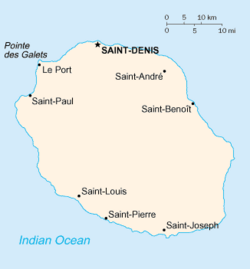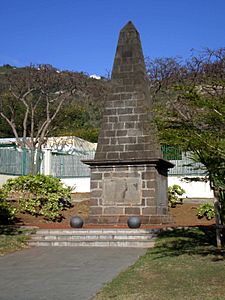Invasion of Île Bonaparte facts for kids
Quick facts for kids Invasion of Île Bonaparte |
|||||||
|---|---|---|---|---|---|---|---|
| Part of the Napoleonic Wars | |||||||
 Île Bonaparte. The invasion forces landed either side of the capital Saint Denis. |
|||||||
|
|||||||
| Belligerents | |||||||
| Commanders and leaders | |||||||
| Josias Rowley Henry Keating |
Chrysostôme de Sainte-Suzanne | ||||||
| Strength | |||||||
| 3,650 soldiers 5 frigates |
576 soldiers 2,717 militia |
||||||
| Casualties and losses | |||||||
| 22 killed 79 wounded |
Casualties unknown. The island, entire garrison and large quantities of military equipment captured. | ||||||
The Invasion of Île Bonaparte was a military attack by the British in 1810. It was a key part of Britain's plan to take over French islands in the Indian Ocean during the Napoleonic Wars. These islands were Île Bonaparte (now called Réunion) and Isle de France (now Mauritius).
The French used these islands as a base for their warships, called frigates. These ships, led by Commodore Jacques Hamelin, would attack British trade ships. These British ships, known as East Indiamen, carried goods between Britain and British India. Hamelin's ships had captured many British ships the year before.
To stop this, British Commodore Josias Rowley attacked Saint Paul on Île Bonaparte. He captured one of Hamelin's frigates and two British trade ships that the French had taken. This success made Rowley think about taking over the whole island.
Rowley and Lieutenant-Colonel Henry Sheehy Keating of the British Army made a plan. They would use the small British-held island of Rodriguez as their base. Their plan was to land two groups of soldiers near Saint Denis, the island's capital. They hoped to make the French governor surrender quickly. This would happen before the island's local soldiers, called militia, could gather to fight them.
The attack began on July 7, 1810. British sailors, soldiers, sepoys (Indian soldiers), and Royal Marines landed on different beaches. Some men drowned in the strong waves. But most of the soldiers reached the shore safely. They marched inland, attacking French outposts as they got closer to the capital. The French commander, Colonel Chrysostôme de Sainte-Suzanne, saw that his soldiers were not ready to fight. He also knew the militia would take too long to arrive. So, he surrendered the island, its soldiers, and all its supplies to Rowley.
Contents
Why the Invasion Happened
The French islands of Île Bonaparte and Isle de France were important bases. For many years, French ships had used them to attack British trade ships. In 1808, France wanted to use these islands even more. They sent Commodore Jacques Hamelin with powerful warships to target British trade. Hamelin's ships were very successful in 1809. They captured several British trade ships and even some smaller British warships.
To fight back, British Admiral Albemarle Bertie sent Commodore Josias Rowley. Rowley's job was to stop the French ships and get ready for an invasion. Rowley's ships did manage to get back one British trade ship. But the large French ships could still leave their safe harbors easily.
Rowley asked for more soldiers from Madras (in India). These soldiers, from the British Army and the Honourable East India Company (HEIC), helped capture the small island of Rodriguez. Rodriguez became a useful base for the British. Their ships could get supplies and repairs there. Before, they had to go all the way back to Madras or the Cape of Good Hope. This new base meant Rowley's ships could spend more time fighting the French.
The Attack on Saint Paul
In September 1809, Rowley led an attack on the harbor of Saint Paul on Île Bonaparte. This attack showed that Rowley could strike directly at French bases. British soldiers, sailors, and Royal Marines landed on unguarded beaches. They attacked the French defenses from the land side and quickly defeated the French. This allowed Rowley's ships to enter the harbor. They captured a French ship called Caroline and other smaller ships. Rowley destroyed the defenses and public buildings in the town. He then left with many captured supplies and ships. After this attack, Colonel Chrysostome Sainte-Suzanne took over from the previous French commander. But he knew he could not defend the island well if a full invasion happened.
Getting Ready for the Invasion
In early 1810, the stormy season ended. French Commodore Hamelin sent ships to attack British trade ships again. Meanwhile, the British were already planning their next move. In late June, Rowley sailed to Rodriguez with two of his warships. There, he met with Lieutenant Colonel Henry Sheehy Keating. They decided the best way to invade the island was to land soldiers on both sides of Saint Denis, the capital. They would defeat the French soldiers outside the town. This would force the new French governor to surrender.
Over the past year, the British had sent more soldiers to Rodriguez. By June 1810, there were over 3,650 men. This included 1,800 British Army soldiers and 1,850 HEIC sepoys. Rowley used his own warship, HMS Boadicea, and HMS Nereide to carry these troops. On July 6, Rowley's ships met with other British warships. Among the people on Boadicea was Robert Townsend Farquhar. He was a British official sent to govern the islands once they were captured.
The Invasion Begins
Rowley's ships arrived at Île Bonaparte on July 7. The main group of ships went to Sainte-Marie. This was a trick to draw French soldiers away from another place called Grande Chaloupe. At Grande Chaloupe, the British ship Sirius secretly landed the first group of soldiers. This group had 950 soldiers, some small cannons, and supplies. They landed safely and quickly took control of the high ground near the beach. They drove off French guards and cut the main road. This made it hard for the French to communicate or send help.
On the other side of Saint Denis, to the east, Rowley ordered his forces to land. The first boat to approach the beach was a small ship called Estafette. But the wind grew strong, creating huge waves. The waves crashed the ship onto the shore, breaking it apart. Four of the 150 men on board drowned. Keating saw that smaller boats would also be destroyed. So, he ordered a small ship called Ulney to be driven onto the shore. This ship acted like a wall, protecting other boats. This allowed more boats to reach the beach safely. But it was not enough for everyone to land before nightfall.
By the morning of July 8, the French had still not gathered all their soldiers. They had 576 regular soldiers and 2,717 local militia spread out across the island. Rowley and Captain Lambert successfully landed their soldiers at Grande Chaloupe. This gave Keating enough men to march on Saint Denis. While Keating was landing, the other British force had already attacked the capital from the west. They stormed a French barricade on the road and defeated the defenders easily. The British forces pushed through French resistance in small fights. Keating and his men closed in on Saint Denis. At 6:00 PM, French representatives met the advancing British. They signed an agreement to surrender the entire island, its soldiers, and supplies to Rowley, Keating, and Farquhar.
Off the coast, the British ship Sirius was blocking the harbor of Saint Paul. On July 9, Sirius saw a ship trying to escape the harbor. This ship had heard about the surrender. Sirius sent a small boat to chase it. After a long twelve-hour chase, the British caught the ship. It was a privateer (a private warship) called Edward, with four guns and 30 men. The British quickly defeated the crew. They found important messages from the French government for officials on Isle de France. All these messages fell into British hands.
What Happened Next
The invasion cost the British 22 dead and 79 wounded. This included those who drowned when Estafette was wrecked. Most other injuries happened in small fights on the road to Saint Denis. We don't know how many French soldiers were hurt, but it was probably a similar number. The French did not fight back very hard. The British quickly landed and took French outposts without much trouble.
After the invasion, the island went back to its old name, Bourbon. This was its name before the French Revolution. Farquhar became the governor for a short time. Then he moved to Mauritius when that island was captured later in 1810. Keating took over as governor and stayed until 1814. The island was given back to France when the Napoleonic Wars ended.
This success allowed the British to focus on the last French territory in the Indian Ocean, Isle de France. Bourbon provided safe harbors and plenty of supplies for the British ships. It became Rowley and Keating's new headquarters. With a safe base nearby, Rowley could send his ships to attack French ports on Isle de France more often. He also planned to take small islands near the main harbors. This would stop French ships from using those ports as raiding bases. This plan later led to a terrible event called the Battle of Grand Port. In that battle, four of Rowley's ships were lost.
Monuments



